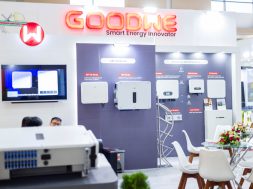
A glut that drives prices lower will help the uptake of photovoltaic technology.
Remember how there was a glut of computer chips in 2008, and then the world stopped using computer chips? Yeah, me neither.
That’s a good reason to discount your worries about the effects on solar power from recent policy blows on panel manufacturers by the U.S. and Chinese governments.
The falls in the share prices of some major producers have certainly been dramatic – 43 percent so far this year for JinkoSolar Holding Co., 20 percent for Canadian Solar Inc., and 4.4 percent for Hanwha Q Cells Co. But to date, what hasn’t killed the solar industry has only made it stronger.
Weakness Is Strength
Falling solar module prices have been great for the solar industry
To see why, reflect upon some history. Solar module prices slumped 80 percent between 2010 and 2017 as rising efficiencies and burgeoning supply pushed down expenses. That process put many manufacturers out of business – but the plummeting costs caused global installed capacity to increase almost nine-fold, and the victors of that market battle have since done well on the spoils.
Those who bought shares in JinkoSolar and Canadian Solar at the end of 2011 when the market was in crisis had received total returns of 33 percent a year and 22 percent a year respectively by the end of last week. That compares to 22 percent and 17 percent for investors in Taiwan Semiconductor Manufacturing Co. and Intel Corp. over the same period.
Value Driver
In EV/Ebitda terms, the valuation of major solar module manufacturers has just returned to multi-year ranges
What will be the impact of the recent policy moves from Washington and Beijing? The Trump administration in January slapped a 30 percent tariff on imported solar panels, one reason that JinkoSolar and Canadian Solar 1 shares are down so much this year, while the Chinese government last week said it would reduce the permits for new utility-scale projects this year and cut the feed-in tariffs that solar generators are paid for their kilowatt-hours.
That’s clearly bad news for incumbent panel manufacturers, but it’s worth considering why. The near-term fall in demand in China – and the increase in supply from manufacturers that have announced 4.55 annual gigawatt-hours of new U.S. production capacity this year in response to Trump’s tariffs – will lead to a glut in the global market that will drive prices lower.
That will hurt the margins of manufacturers, but help the uptake of photovoltaic technology, especially in Asia, where electricity demand is rising fast and utility-scale solar is already at or past the tipping point where its generation costs start to undercut fossil fuels.
n China, module prices – still about a third of the cost of a solar system – should fall 35 percent this year and another 10 to 15 percent in 2019, Yvonne Liu, Yali Jiang and Xiaoting Wang of Bloomberg New Energy Finance wrote in a note Monday. That’s an acceleration of the expected pace before Beijing’s intervention, when a drop of 20 to 27 percent was forecast for 2018.
While aggregate global demand will fall this year because of the decline in Chinese build, those lower prices may stimulate the market in 2019 and 2020, they wrote.
We’ve become so used to large companies extracting a profit from their market power that an industry in which it’s hard to pick the winners three years hence feels like one that’s in a state of crisis. In truth, this is precisely the situation in which capitalism is supposed to excel, for the benefit of all.
Policy changes in 2018 have been bad news for incumbent producers of solar panels. For the industry as a whole – and for the global climate – they’re likely to prove a salutary tonic.
This column does not necessarily reflect the opinion of the editorial board or Bloomberg LP and its owners.
Despite the name, most of Canadian Solar’s production base is in China.











